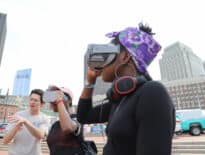
The Dream Cabin at Yotel includes perforated panels to regulate the color and intensity of changing LED light. Image courtesy of Stantec
Heavy eyelids, aching limbs, foggy brain. You’re slow – to move, react, think – and a little clumsy. Add jet lag on top of that and you’re completely out of sorts, and perhaps feeling a little ill. Yet you need to perform. That presentation in the morning isn’t going to wow the client by itself.
You need sleep. You tried to get a good rest at the hotel last night, but it’s always the same story: no one ever sleeps well during their first night in a hotel.
Sound familiar? You’re not alone. We want to change that. By combining research on sleep and circadian rhythms with design and technology, we think we can help people get all 40 of their well-earned winks by designing a better hotel room: The Dream Cabin.
Stantec’s Boston Dream Lab team office is collaborating with Dr. Steven Lockley, a neuroscientist and circadian lighting expert at Brigham and Women’s Hospital, a teaching hospital for Harvard Medical School. Our team has partnered with the Yotel Hotel in Boston, where we will be implementing the design for the Dream Cabin, where theories about designing for better sleep can be put into practice.
In addition to helping guests sleep better, there’s a business case behind this project: Designing a hotel for the 21st century.
Designing the Dream
What, exactly, are we doing to create a Dream Cabin that promotes restful slumber? Working with Lockley to understand the science of sleep, we designed a Yotel room that incorporates the correct spectrum and intensity of light to help alert the brain in the morning or prepare the brain for sleep at night. We are also setting the room temperate according to the human circadian rhythms in order to optimize the sleep process. We have designed a circadian light canopy over the bed using custom acoustic perforated panels from Arktura to integrate the color and intensity changing LED light.
We designed a Yotel room that incorporates the correct spectrum and intensity of light to help alert the brain in the morning or prepare the brain for sleep at night.
By combining sleep-related neuroscience and programmable smart home technology, the room will adjust lighting and temperature throughout the day, encouraging sleepiness and a reasonable bedtime in the evening, and energy and wakefulness in the morning.

Pilar Botana
This is a great step toward bridging the gap between science and architecture. We understand how the system works in a controlled environment, but we are now applying that information to the real world. The scientists learn from us in understanding practical applications, while we – the designers – are learning from them and reinventing the way we think about the built environment and health.
But most importantly, we all have our sleep issues, and we want to help alleviate some of those for travelers.
Potential Applications Beyond Hotels
The Dream Cabin team received funding, time and support from Stantec’s Greenlight Program, which supports our employees’ great ideas. For our group, the project is more than a passion. It’s education, it’s collaboration, it’s an experience.

Maria Santos
We plan to document the Dream Cabin design process and create a set of guidelines that can be adopted by a new generation of hotels. But hopefully it doesn’t stop there.
Sleep is an important topic in college settings. Then there’s workplace, residential, and hospital settings where the quality of patient sleep directly affects healing time. There are a huge number of applications for this combination of design and technology that we are excited to explore.
Pilar Botana is the director of design visualization and Maria Santos is an interior designer at Stantec Architecture Boston.




 |
| 

